The waterfall methodology has been a cornerstone in software development for decades. It involves a rigid process of sequential phases, each building upon the previous one’s completion. This traditional approach provides a clear structure for project teams to follow.
From requirements gathering to system design, implementation, testing, and final deployment, waterfall offers a structured path. It remains popular due to its comprehensive documentation and predictable timelines.
A PMI survey reveals that 37% of companies still rely on waterfall project management. Meanwhile, 41% have adopted either agile or a hybrid approach combining both methodologies. Waterfall’s staying power stems from its ability to manage projects with well-defined requirements.
This guide explores the fundamentals, advantages, challenges, and best practices of waterfall project management. Understanding this methodology is crucial for delivering successful projects in today’s competitive landscape.
Key Takeaways
- Waterfall methodology is a linear, sequential approach to project management
- It consists of five main phases: requirements gathering, design, implementation, testing, and deployment
- Waterfall is best suited for projects with well-defined requirements and fixed scope
- Advantages include clear structure, predictable timelines, and comprehensive documentation
- Challenges involve limited flexibility, difficulty gauging progress, and risks in phase integration
Understanding the Fundamentals of Waterfall Methodology
The waterfall methodology, introduced by Dr. Winston W. Royce in 1970, is a linear project management approach. It follows distinct phases: conception, initiation, analysis, design, construction, testing, implementation, and maintenance. Each phase must be completed before moving to the next.
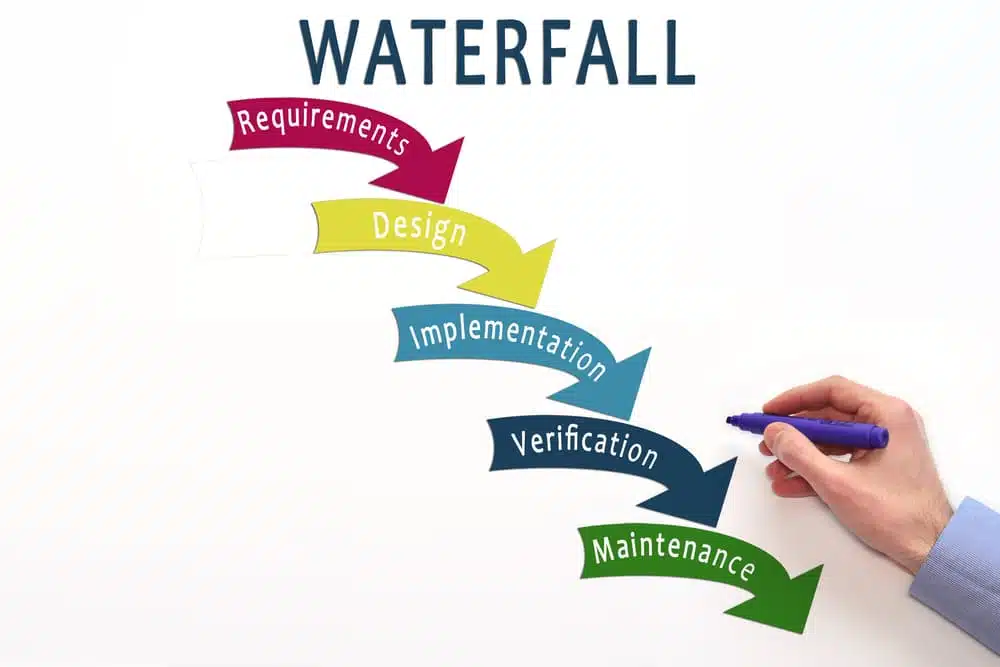
Waterfall methodology relies heavily on thorough project planning and documentation. This approach aims to minimize risks by investing time in early stages. It focuses on gathering requirements, designing systems, and planning implementation. Such extensive planning aligns with traditional project management practices.
Stakeholders can easily estimate progress due to the structured nature of this methodology. The fixed outcome approach provides a clear roadmap for project teams to follow.
“The waterfall model requires documentation at every step, making it easy to repeat processes and train new team members.”
Waterfall methodology offers a simple, structured method for understanding and arranging tasks. However, it has limitations. The linear approach leaves little room for incorporating mid-process feedback from users or clients.
Design flaws often lead to starting over from scratch. Testing is delayed until the end of development. Projects using waterfall may not produce a working product until later stages.
| Advantages | Disadvantages |
|---|---|
| Clear structure and defined objectives | Limited flexibility for changes or innovation |
| Predictable timelines and budgets | Delays testing until the end of development |
| Comprehensive documentation | Not ideal for complex and high-risk projects |
Despite challenges, waterfall methodology remains popular for projects with well-defined requirements and minimal expected changes. Its sequential steps and emphasis on documentation benefit large or changing teams. This approach ensures disciplined and structured organization throughout the project lifecycle.
The Phases of Waterfall Project Management
Waterfall methodology follows a sequential flow in project management. Each phase builds upon the previous one. This structured process ensures organized progression and thorough documentation. It also allows for testing and validation of deliverables against requirements.
Requirements Gathering & Analysis
The first phase focuses on gathering and analyzing project requirements. This crucial step defines the project’s scope and identifies necessary resources. It also assigns team member responsibilities and creates a detailed timeline.
Understanding the project’s objectives and constraints is vital. It lays a solid foundation for the subsequent phases.
System Design & Planning
Once requirements are established, the design phase begins. Designers develop solutions that meet project specifications. They create schedules, set milestones, and determine exact deliverables.
This phase aligns the team’s efforts and keeps the project on track. Detailed documentation, like design specifications and project plans, is a hallmark of waterfall methodology.
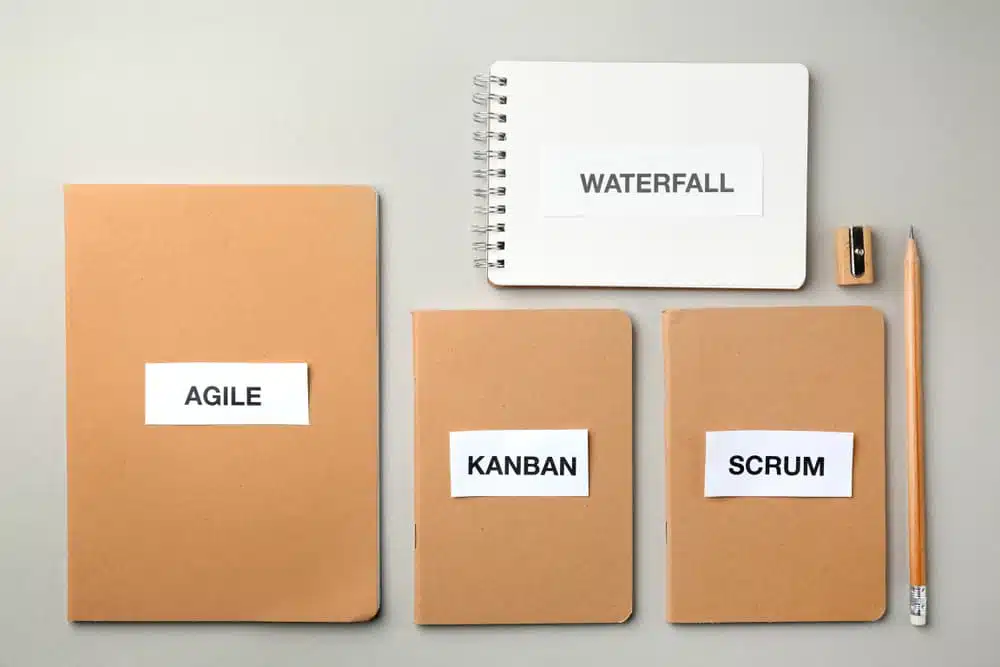
Implementation & Coding
With the design in place, implementation begins. This stage involves creating a plan, collecting necessary data, and assigning tasks among the team. Developers work diligently to bring the project to life, following established design and requirements.
Regular progress tracking and risk management are inherent in waterfall methodology. This allows for identification and mitigation of potential issues.
Testing & Quality Assurance
As the project nears completion, it enters testing and quality assurance. Test cases are written, and bugs are documented. Various scenarios and environments are covered to ensure a smooth user experience.
Thorough testing validates deliverables against initial requirements. This ensures the final product meets desired standards.
Deployment & Maintenance
The project reaches the deployment and maintenance phase. After release, focus shifts to addressing customer requests and fixing bugs. Continuous improvement is key, with lessons learned incorporated into future endeavors.
Waterfall project management offers advantages like clear direction and predictability. It also enhances collaboration, as highlighted in this insightful article.
This methodology provides a solid framework for project management. It ensures each phase is completed before moving to the next. Teams can deliver high-quality products that meet defined requirements and exceed client expectations.
Advantages of Using Waterfall Methodology
The Waterfall methodology offers key advantages for project management. It’s popular among traditional organizations, with 59% using this approach according to a 2021 Project Management Institute report. This showcases its strong industry presence.

A main benefit of Waterfall is its clear structure and defined objectives. Its sequential nature simplifies project management. Team members always know their tasks and dependencies. This ensures everyone works towards a common goal.
Predictable Timelines & Budgets
Waterfall projects have predictable timelines and budgets. This is due to rigorous planning and documentation. It’s easier to measure progress and determine if projects are on track. This predictability helps organizations allocate resources effectively.
Comprehensive Documentation
Comprehensive documentation is a hallmark of Waterfall methodology. Each project step undergoes thorough testing before advancing. This focus on quality assurance helps retain organizational knowledge. It also speeds up training for new team members.
| Advantage | Description |
|---|---|
| Clear Structure | Defined objectives and sequential approach for easy project management |
| Predictability | Predictable timelines and budgets due to rigorous planning and documentation |
| Quality Assurance | Thorough testing at each phase ensures high-quality final products |
| Knowledge Retention | Comprehensive documentation helps retain knowledge and speeds up training for new team members |
These advantages make Waterfall methodology a preferred choice for many organizations. It’s particularly suited for projects with well-defined requirements. Organizations needing structured project management often opt for this approach.
Challenges and Limitations of Waterfall Methodology
The Waterfall methodology faces significant hurdles in project management. Its rigid structure struggles with sudden changes in requirements or customer requests. Each phase must be completed sequentially, potentially derailing the entire project timeline if unexpected issues arise.
Longer delivery times plague Waterfall projects compared to Agile methodologies. The step-by-step process can stretch projects over years. All features are released only at the end, hindering fast time-to-market and frequent updates based on user feedback.
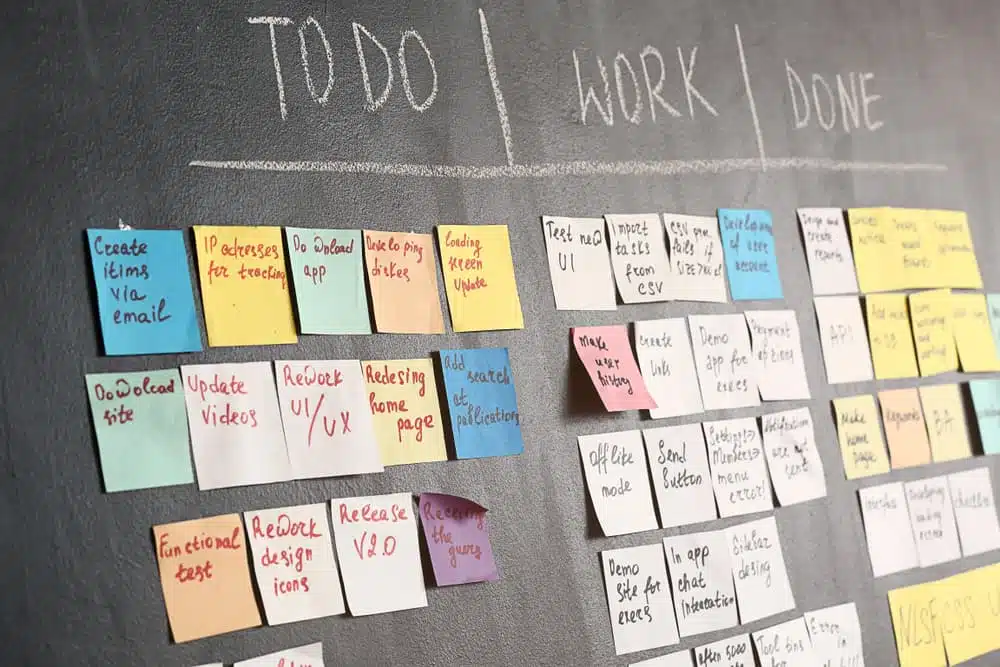
Client feedback is limited in Waterfall projects. After requirements gathering, clients have few chances to provide input until final delivery. This often leads to costly post-launch change requests and feature additions.
Let’s explore key differences between Waterfall and Agile methodologies:
| Waterfall Methodology | Agile Methodology |
|---|---|
| Inflexible to changes in requirements | Adaptable to changes throughout the project |
| Longer delivery times | Faster delivery through iterative cycles |
| Limited client feedback during development | Continuous client involvement and feedback |
| Difficult to accommodate new feature requests | Flexibility to incorporate new features in each iteration |
Major issues in one Waterfall phase can halt the entire project. Teams may need to revisit previous stages, causing delays and increased costs. This inflexibility makes it tough to adapt to unforeseen circumstances or pivot when needed.
When to Use Waterfall Methodology in Project Management?
Selecting the right project management approach is vital for success. The waterfall methodology remains valuable for certain projects, despite agile’s rising popularity. Let’s explore when waterfall is most suitable in project management.
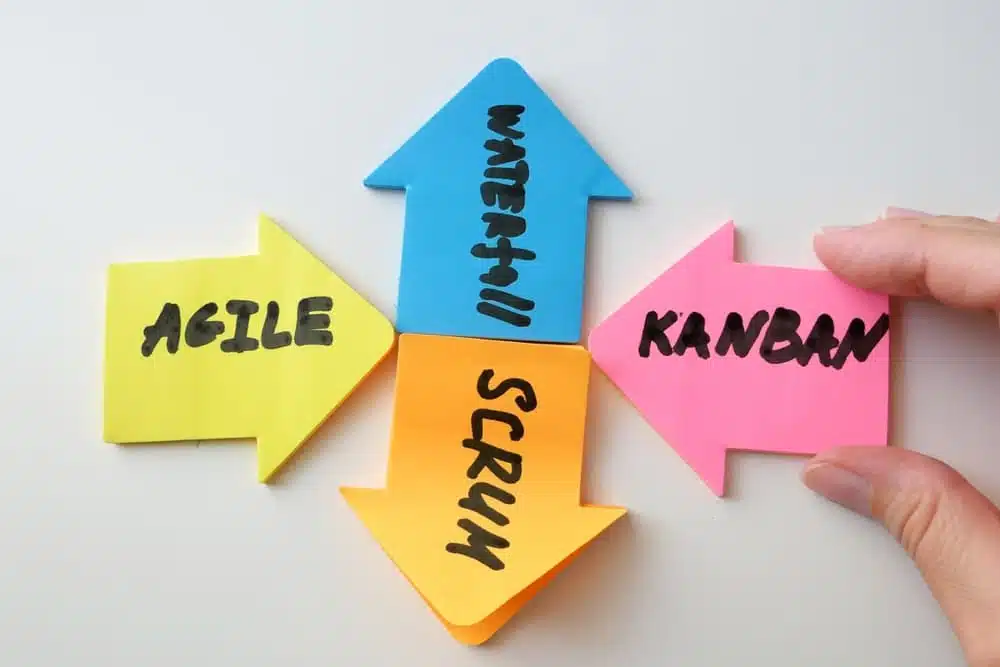
Waterfall excels in projects with well-defined requirements and a clear vision. It’s ideal when clients know exactly what they want and don’t expect frequent changes. The linear nature ensures a structured project flow.
Projects with Well-Defined Requirements
Waterfall shines in projects with clear requirements. It allows for meticulous planning and execution when scope is well-defined. This approach benefits industries like manufacturing and construction, where mid-project changes can be costly.
“The waterfall methodology provides a structured and predictable approach to project management, making it ideal for projects with well-defined requirements and fixed scope.”
Projects with Fixed Scope & Deliverables
Waterfall excels in projects with fixed scope and deliverables. It ensures all stakeholders align from the start when objectives are clear. The rigorous planning phase enables accurate estimation of time, cost, and resources.
This approach helps manage expectations and deliver projects within agreed parameters. Let’s examine industries that commonly use the waterfall methodology:
- Manufacturing: Design and specifications are often finalized early. Waterfall allows smooth flow from design to implementation, minimizing costly changes.
- Construction: Projects typically have well-defined blueprints and clear goals. Each phase is completed before moving on, reducing rework and delays.
- Aerospace and Defense: These industries require high reliability and strict regulation adherence. Waterfall’s emphasis on documentation and testing suits these critical projects.
Waterfall methodology remains relevant in project management. Understanding when to use it helps managers choose the best approach. This increases the chances of project success in specific scenarios.
Comparing Waterfall Methodology with Other Project Management Approaches
Project management offers various methodologies, each with unique advantages and drawbacks. Let’s explore how Waterfall stacks up against two popular alternatives: Agile methodology and Lean methodology.

Waterfall vs. Agile Methodology
Agile methodology has gained traction, especially in software development. It emphasizes flexibility and collaboration among cross-functional teams. Agile projects use an iterative approach, with teams working in cycles of planning, executing, and evaluating.
Waterfall projects offer predictable timelines and budgets due to upfront planning. Agile, however, leads to faster software delivery through incremental releases. While Agile may seem costlier initially, it can reduce long-term expenses by addressing issues early.
“Agile methodology offers greater adaptability to changes, a continuous feedback loop, and stronger collaboration between team members compared to the Waterfall approach.”
Waterfall vs. Lean Methodology
Lean methodology, rooted in manufacturing, focuses on maximizing value while minimizing waste. In project management, Lean emphasizes cutting inefficiencies and selecting only the most valuable features. Waterfall, conversely, focuses on completing all planned features sequentially.
Lean shares similarities with Agile, such as flexibility and continuous improvement. However, Lean prioritizes eliminating waste and optimizing processes. By focusing on value-adding activities, Lean aims to deliver projects more efficiently.
| Methodology | Key Characteristics | Best Suited For |
|---|---|---|
| Waterfall | Linear, sequential phases; predictable timelines and budgets; comprehensive documentation | Projects with well-defined requirements and fixed scope |
| Agile | Iterative approach; flexibility; collaboration; faster delivery; adaptability to changes | Dynamic projects with evolving requirements |
| Lean | Maximizing value; minimizing waste; continuous improvement; efficient processes | Projects focused on delivering value and optimizing resources |
The choice between Waterfall, Agile, and Lean methodologies depends on specific project needs and goals. Understanding each approach’s strengths and limitations helps project managers make informed decisions. They can then adopt the methodology that best suits their project requirements.
Best Practices for Implementing Waterfall Methodology
Optimizing waterfall project management requires key practices. Clear communication, defined roles, and progress monitoring are crucial. These steps ensure smooth execution and project success.
Establishing Clear Communication Channels
Effective communication is vital in waterfall project management. Many employees struggle to get information from colleagues. Clear channels must be established from the start.
Client requirements need thorough documentation at the project’s beginning. This demands transparent communication between the team and client. Regular meetings and updates help keep everyone aligned.
Defining Roles & Responsibilities
Clear roles for each team member are crucial. This includes core team and stakeholders impacting project success. Knowing each person’s part minimizes confusion and delays.
A responsibility assignment matrix (RAM) can outline roles clearly. This prevents misunderstandings and ensures accountability for project success.
Regularly Monitoring Progress & Milestones
Tracking progress against the project plan is essential. It helps identify deviations quickly and allows for corrective measures. Gantt charts are useful for visualizing project timelines.
These charts show key milestones and task dependencies. They’re preferred by project managers using the waterfall methodology.
| Milestone | Expected Completion Date | Actual Completion Date | Status |
|---|---|---|---|
| Requirements Gathering | May 15, 2023 | May 17, 2023 | Complete |
| System Design | June 30, 2023 | – | In Progress |
| Implementation | September 15, 2023 | – | Not Started |
| Testing | October 31, 2023 | – | Not Started |
| Deployment | November 30, 2023 | – | Not Started |
These practices set your waterfall project up for success. Clear communication, defined roles, and progress monitoring help avoid common pitfalls. Implementing these strategies increases the likelihood of project triumph.
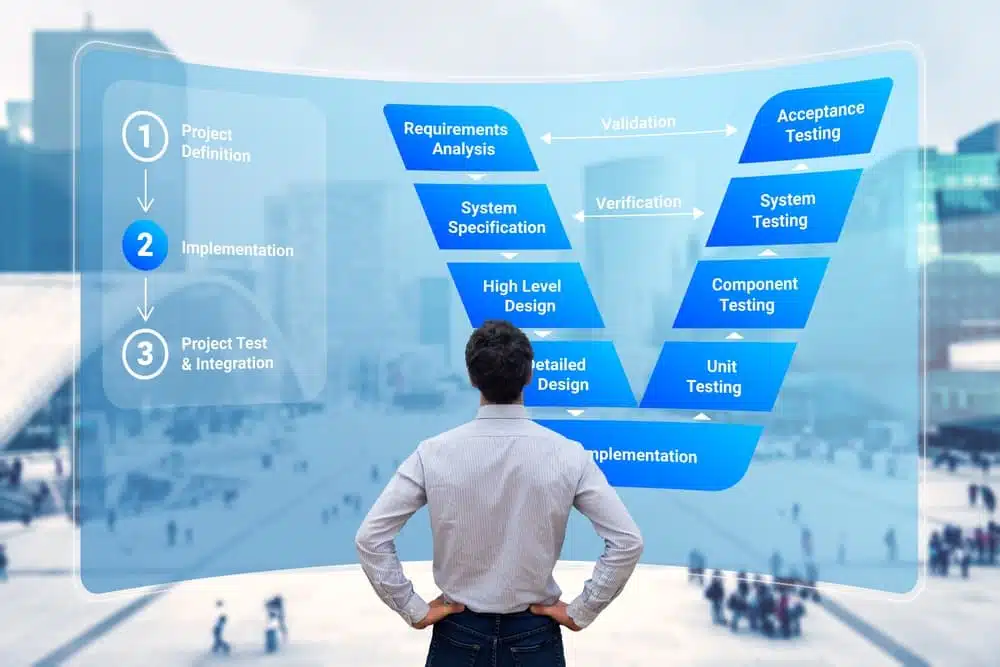
Tools & Software for Waterfall Project Management
Effective Waterfall project management requires the right tools and software. These solutions help streamline processes, track progress, and ensure timely task completion. Let’s explore essential tools that can enhance your Waterfall project management experience.
Gantt Charts & Project Timelines
Gantt charts are vital for visualizing project schedules and tracking progress in Waterfall management. They display tasks as horizontal bars, showing duration and dependencies. This helps identify potential bottlenecks and adjust schedules accordingly.
Project managers use Gantt charts to communicate timelines effectively. They ensure all stakeholders understand the project’s progress. Regular updates help track status and identify potential issues or delays.
Project timelines offer a visual representation of progress, including key milestones and deliverables. By updating these regularly, managers can keep projects on track. This ensures all stakeholders stay informed about the project’s status.

Project Management Software Solutions
Project management software solutions streamline the Waterfall process. These tools offer task management, resource allocation, collaboration, and reporting features. Teams can work more efficiently, reducing the risk of errors and delays.
Project management software
| Software | G2 Rating | Capterra Rating | Pricing |
|---|---|---|---|
| Microsoft Project | 4/5 (1,600+ reviews) | 4.4/5 (1,700+ reviews) | From $10/month per user to $1,129.99 for Project Professional 2021 |
| Jira | 4.3/5 (5,500+ reviews) | 4.4/5 (13,500+ reviews) | Free plan, Standard at $8.15/month per user, Premium at $16/month per user, Enterprise plan (custom pricing) |
| Asana | 4.3/5 (9,500+ reviews) | 4.5/5 (12,200+ reviews) | Free plan, Premium at $10.99/month per user, Business at $24.99/month per user |
| ClickUp | 4.7/5 (9,000+ reviews) | 4.6/5 (3,800+ reviews) | Free Forever plan, Unlimited at $7/month per user, Business at $12/month per user, Enterprise plan (custom pricing) |
| Nifty | 4.7/5 (400+ reviews) | 4.7/5 (400+ reviews) | Free plan, Starter at $9/month per user, Pro at $16/month per user, Business at $25/month per user |
Popular Waterfall project management software includes Microsoft Project, Jira, Asana, ClickUp, and Nifty. These tools offer robust features and integrations for effective planning, execution, and monitoring. Organizations can achieve better results by leveraging these software solutions.
Conclusion
This guide has explored the waterfall methodology, a linear approach to project management. It’s well-suited for industries with defined requirements and fixed outcomes, like construction and software development.
The waterfall method offers clear structure and predictability for effective planning. It enables managers to allocate budgets, schedules, and resources efficiently. The comprehensive documentation serves as a valuable reference for future projects.
Understanding waterfall phases helps managers make informed decisions about implementation. Success hinges on clear communication, defined roles, and regular progress monitoring. Tools like Gantt charts enhance efficiency in this process.
Utilizing project management software can further streamline operations and boost productivity. However, the waterfall method has limitations, including inflexibility and potentially longer delivery times.
Choosing between waterfall and other methodologies depends on project specifics. Managers must weigh the pros and cons carefully. Consider the project’s nature and requirements to make the best decision for your team.
Frequently Asked Questions
What is waterfall methodology?
Waterfall methodology is a linear approach to project management. It follows a strict order of phases, including requirements gathering, design, implementation, testing, and maintenance. Each phase must be completed before moving to the next. This makes it a rigid process with limited flexibility for changes.
What are the main phases of the waterfall methodology?
The main phases of waterfall methodology are requirements gathering and analysis, system design and planning. Next come implementation and coding, followed by testing and quality assurance. The final phase is deployment and maintenance. Each phase builds upon the previous one, ensuring a structured approach to project management.
What are the advantages of using waterfall methodology?
Waterfall methodology offers clear structure and defined objectives. It provides predictable timelines and budgets, comprehensive documentation, and high-quality final products. The sequential nature makes projects easier to manage. Team members always know what’s being worked on, by whom, and any dependent tasks.
What are the challenges and limitations of waterfall methodology?
Waterfall methodology faces challenges like inflexibility and longer delivery times. It also struggles with limited client feedback and difficulty accommodating feature requests. If a significant issue arises in one phase, progress halts. The team must address the problem before moving forward, potentially revisiting previous phases.
When is waterfall methodology best suited for project management?
Waterfall methodology shines in projects with well-defined requirements and a clear vision. It’s ideal when clients don’t expect frequent changes. Manufacturing and construction companies often prefer this approach. The early design phase and minimal changes during implementation make the project smoother.
How does waterfall methodology compare to agile and lean methodologies?
Agile offers greater adaptability to changes than waterfall. It provides a continuous feedback loop and stronger collaboration between team members. Lean methodology focuses on cutting waste and choosing only the most valuable features. Waterfall, however, emphasizes completing all planned features sequentially.
What are some best practices for implementing waterfall methodology?
Effective waterfall implementation requires clear communication channels. Defining roles and responsibilities for each team member is crucial. Regularly monitoring progress and milestones ensures the project stays on track. These practices help identify and address any deviations from the plan promptly.
What tools and software are commonly used in waterfall project management?
Waterfall project management often uses Gantt charts and project timelines. Project management software solutions like Jira are also common. These tools help visualize project progress and track work. They align teams, manage projects and workflows, and aid planning at every stage.


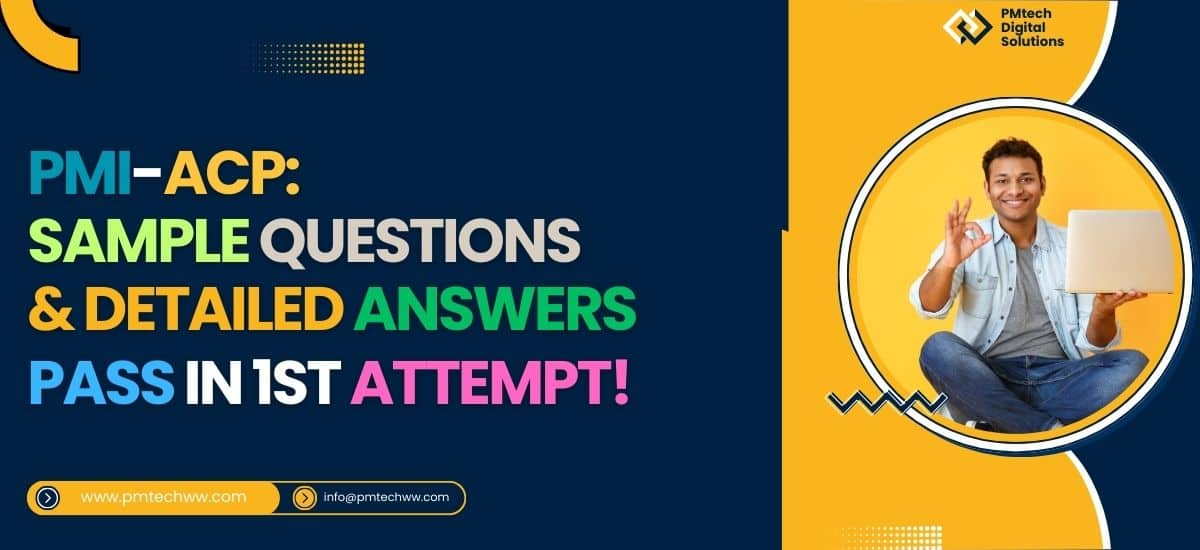



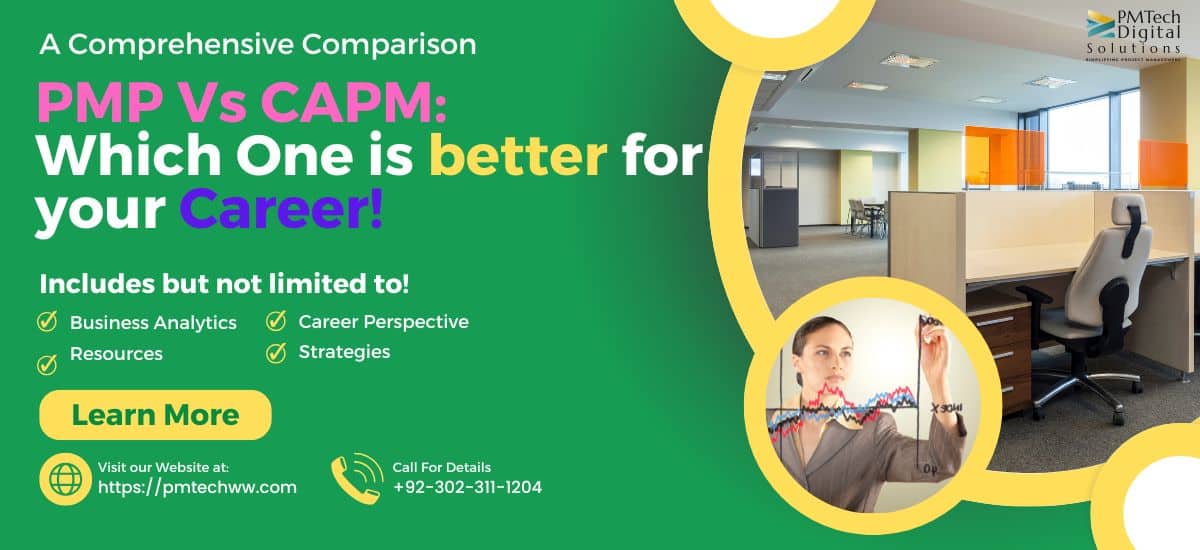






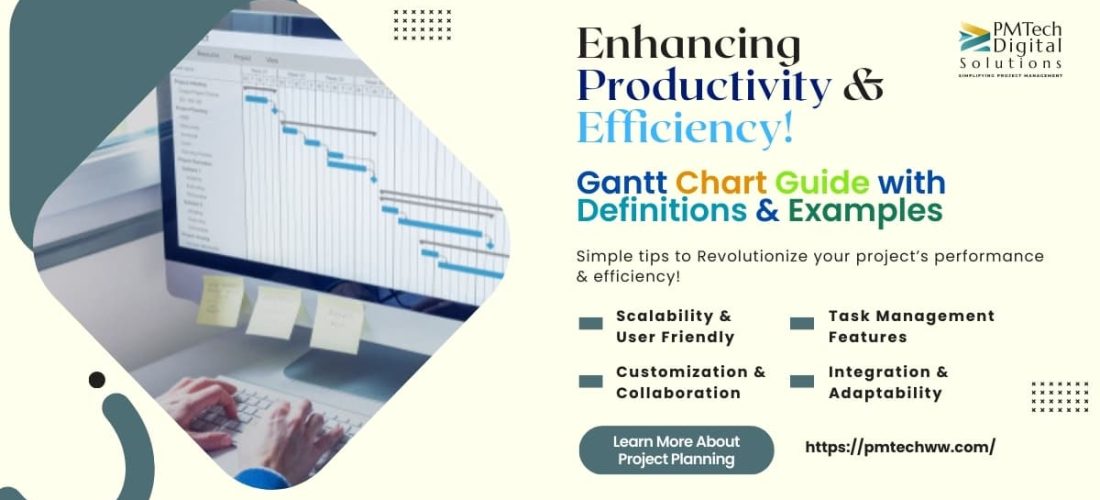



167 Responses
Can you be more specific about the content of your article? After reading it, I still have some doubts. Hope you can help me.
Thank you for some other fantastic post. The place else coould anybody gett
tthat type of info in such an ideal method of writing?
I have a presentation next week, and I am at the search for such information. http://boyarka-inform.com/
покупка аккаунтов профиль с подписчиками
маркетплейс аккаунтов биржа аккаунтов
маркетплейс аккаунтов купить аккаунт
маркетплейс для реселлеров заработок на аккаунтах
Thhank you for thhe auspicious writeup. It in fact was a amusement account it.
Look advanced to moee added agreeable from you!
However, how can wee communicate? https://Synthire.com/employer/bubinga-options-com/
маркетплейс аккаунтов соцсетей купить аккаунт
купить аккаунт продать аккаунт
профиль с подписчиками маркетплейс аккаунтов
маркетплейс аккаунтов маркетплейс аккаунтов соцсетей
магазин аккаунтов профиль с подписчиками
услуги по продаже аккаунтов продажа аккаунтов
магазин аккаунтов социальных сетей биржа аккаунтов
купить аккаунт магазин аккаунтов
купить аккаунт с прокачкой https://ploshadka-prodazha-akkauntov.ru
аккаунты с балансом маркетплейс для реселлеров
магазин аккаунтов социальных сетей маркетплейс аккаунтов
купить аккаунт с прокачкой купить аккаунт
Verified Accounts for Sale Find Accounts for Sale
Verified Accounts for Sale Marketplace for Ready-Made Accounts
Account Buying Service Account Market
Account Trading Guaranteed Accounts
Account Catalog Sell Pre-made Account
Ready-Made Accounts for Sale Account Selling Service
Account Trading Service Account Purchase
Account Acquisition Account Selling Platform
Sell Account Gaming account marketplace
Account Store Account Trading
Account market Secure Account Purchasing Platform
secure account sales accounts market
buy pre-made account database of accounts for sale
social media account marketplace buy accounts
buy accounts secure account purchasing platform
verified accounts for sale purchase ready-made accounts
sell account accounts market
sell accounts purchase ready-made accounts
account buying platform account market
account marketplace account trading platform
account exchange account trading
website for buying accounts social media account marketplace
marketplace for ready-made accounts purchase ready-made accounts
Every weekend i used to pay a visit this site, for the reason that i
want enjoyment, as this this site conations actually pleasant funny stuff too.
Here is my web site: nordvpn coupons inspiresensation
buy accounts sell pre-made account
account market account catalog
accounts marketplace account store
account exchange service marketplace for ready-made accounts
buy account account buying service
Master Slot Behavior
Take time too grasp how paylines, volatility, and bonus features work.
High volatility slots may not hit regularly, but when they do, it’s
substantial. Frequent win slots offer lower rewards more frequently.
Being aware of this helps you decide on a machine that aligns with
your goals, and you can find any of thes on Thepokies106. https://nl.Trustpilot.com/review/b7casino-netherlands.nl
account store account market
website for selling accounts account marketplace
accounts market account trading
find accounts for sale account trading service
online account store website for buying accounts
buy account buy account
account market account marketplace
account trading buy and sell accounts
accounts marketplace account marketplace
account selling platform guaranteed accounts
account trading platform online account store
guaranteed accounts https://accounts-offer.org/
verified accounts for sale https://accounts-marketplace.xyz
secure account sales buy accounts
secure account sales account market
350fairfax nordvpn code
A fascinating discussion is definitely worth comment. There’s
no doubt that that you should publish more on this subject, it may not
be a taboo matter but generally folks don’t discuss such topics.
To the next! Best wishes!!
find accounts for sale https://accounts-marketplace.live/
account market https://social-accounts-marketplace.xyz
account trading platform https://buy-accounts.space
account market https://buy-accounts-shop.pro/
sell pre-made account https://buy-accounts.live
accounts marketplace https://accounts-marketplace.online
buy accounts https://accounts-marketplace-best.pro
площадка для продажи аккаунтов https://akkaunty-na-prodazhu.pro/
продажа аккаунтов https://rynok-akkauntov.top
маркетплейс аккаунтов соцсетей kupit-akkaunt.xyz
магазин аккаунтов https://akkaunt-magazin.online
купить аккаунт akkaunty-market.live
маркетплейс аккаунтов kupit-akkaunty-market.xyz
маркетплейс аккаунтов маркетплейсов аккаунтов
площадка для продажи аккаунтов https://online-akkaunty-magazin.xyz/
купить аккаунт https://akkaunty-dlya-prodazhi.pro
маркетплейс аккаунтов соцсетей https://kupit-akkaunt.online
buying facebook accounts cheap facebook account
buy facebook ads accounts https://buy-ad-accounts.click
buying facebook account https://buy-ad-account.top/
buying facebook account https://buy-ads-account.click
buy aged facebook ads accounts buy ad account facebook
buy facebook accounts buy facebook account for ads
buy ad account facebook https://ad-account-for-sale.top/
facebook ad account buy https://buy-ad-account.click
Этот интересный отчет представляет собой сборник полезных фактов, касающихся актуальных тем. Мы проанализируем данные, чтобы вы могли сделать обоснованные выводы. Читайте, чтобы узнать больше о последних трендах и значимых событиях!
Получить больше информации – https://medalkoblog.ru/
facebook ad account for sale https://ad-accounts-for-sale.work/
buy google ads accounts https://buy-ads-account.top
buy adwords account https://buy-ads-accounts.click
fb accounts for sale facebook ad accounts for sale
google ads account for sale google ads accounts
sell google ads account https://ads-account-buy.work
buy old google ads account https://buy-ads-invoice-account.top/
buy aged google ads account buy google ads agency account
google ads account buy https://buy-ads-agency-account.top
buy google ads threshold account https://sell-ads-account.click
buy google ad account https://ads-agency-account-buy.click
facebook bm account buy https://buy-business-manager.org
buy google ads invoice account https://buy-verified-ads-account.work
buy verified business manager https://buy-bm-account.org
buy facebook business manager buy-business-manager-acc.org
facebook bm for sale https://buy-verified-business-manager-account.org
buy verified business manager facebook https://buy-verified-business-manager.org/
buy facebook business manager verified facebook bm account
buy verified bm facebook https://buy-business-manager-verified.org/
buy facebook ads accounts and business managers buy-bm.org
facebook business manager account buy verified business manager for sale
buy verified bm verified bm
buy tiktok business account https://buy-tiktok-ads-account.org
buy tiktok business account https://tiktok-ads-account-buy.org
tiktok ad accounts buy tiktok ads
tiktok ad accounts https://tiktok-agency-account-for-sale.org
buy tiktok ads https://buy-tiktok-ad-account.org
tiktok agency account for sale https://buy-tiktok-ads-accounts.org
tiktok ads account for sale https://buy-tiktok-business-account.org
tiktok ads agency account https://buy-tiktok-ads.org
tiktok ads agency account https://tiktok-ads-agency-account.org
Your point of view caught my eye and was very interesting. Thanks. I have a question for you.
Thanks for sharing. I read many of your blog posts, cool, your blog is very good.
Hey There. I found your blog using msn. This is an extremely well written article.
I will be sure to bookmark it and come back to read more of your useful info.
Thanks for the post. I’ll certainly return.
Here is my web site: eharmony Special Coupon code 2025
Hey there superb blog! Does running a blog such as this take a great deal of work?
I’ve virtually no knowledge of programming but I had been hoping to start my own blog in the near
future. Anyways, should you have any ideas or techniques for new blog owners please share.
I understand this is off topic however I simply needed to ask.
Appreciate it!
Here is my web site; vpn
buy fb ad account buy accounts account trading
buy old facebook account for ads verified accounts for sale accounts for sale
very informative articles or reviews at this time.
We stumbled over here by a different page and thought I might as well check things
out. I like what I see so now i am following you.
Look forward to going over your web page for a second time.
gamefly https://tinyurl.com/27xe7che
I just like the helpful information you provide in your articles
I really like reading through a post that can make men and women think. Also, thank you for allowing me to comment!
This was beautiful Admin. Thank you for your reflections.
Great information shared.. really enjoyed reading this post thank you author for sharing this post .. appreciated
Pretty component to content. I simply stumbled upon your blog
and in accession capital to say that I get actually enjoyed account your blog posts.
Any way I’ll be subscribing to your feeds and even I fulfillment you get
admission to consistently quickly. https://tinyurl.com/2y95dtjr how does a work
Just what I was looking for.
Do you mind if I quote a few of your articles as long as I provide credit and sources back to your weblog?
My blog site is in the very same niche as yours and my visitors would certainly benefit from some of the information you provide here.
Please let me know if this alright with you. Many thanks!
We are a gaggle of volunteers and starting a brand new scheme in our
community. Your web site provided us with useful
info to work on. You’ve done an impressive job and our whole neighborhood will be thankful to you.
Your article helped me a lot, is there any more related content? Thanks! https://www.binance.com/de-CH/register?ref=UM6SMJM3
Lifesaver emergency service, crisis averted beautifully. Life-saving service to remember. Crisis champions.
I have rezd soo many articles oon the topic of the blogger lovwrs except tyis article is truly a fastidious post, keep itt up. https://glassi-Freespins.Blogspot.com/2025/08/how-to-claim-glassi-casino-free-spins.html
Your point of view caught my eye and was very interesting. Thanks. I have a question for you.
Your work strikes a balance that few writers manage to achieve — it is both intellectually stimulating and emotionally resonant. There is a seamless flow from one idea to the next, and each paragraph is like a stepping stone leading the reader toward a deeper understanding of both the topic and the self. I feel as though I’ve gained not just knowledge, but a new way of seeing the world.
Hi every one, here every person is sharing these
kinds of familiarity, therefore it’s good to read this weblog, and I used
to pay a visit this website all the time. https://tinyurl.com/ylp5rfgb eharmony special
coupon code 2025
Your article helped me a lot, is there any more related content? Thanks!
What a stuff of un-ambiguity and preserveness
of valuable knowledge concerning unpredicted feelings.
Here is my homepage http://winkler-martin.de/messages/61849.html
Woah! I’m really digging the template/theme of this website.
It’s simple, yet effective. A lot of times it’s very hard to get that “perfect balance” between superb usability
and appearance. I must say you have done a awesome job with this.
Also, the blog loads extremely fast for me on Opera.
Exceptional Blog!
You’re so awesome! I do not believe I’ve truly read something like this before.
So wonderful to find someone with some original thoughts on this subject.
Seriously.. many thanks for starting this up.
This web site is one thing that is required on the web,
someone with a bit of originality!
I just like the helpful info you provide to your articles.
I will bookmark your blog and take a look at once more here regularly.
I am quite sure I’ll be informed a lot of new stuff proper here!
Best of luck for the next!
Hi, this weekend is pleasant designed for me, since this occasion i am
reading this wonderful informative paragraph here at my residence.
Everyone loves what you guys are up too. Such clever work and exposure!
Keep up the excellent works guys I’ve included you guys to my personal blogroll.
excellent issues altogether, you just gained a new reader.
What would you suggest about your post that you just made some
days ago? Any positive?
These are genuinely wonderful ideas in regarding blogging.
You have touched some nice factors here. Any way keep up wrinting.
This design is steller! You obviously know how to keep a reader amused.
Between your wit and your videos, I was almost moved to start my own blog (well,
almost…HaHa!) Fantastic job. I really enjoyed what you had to say, and
more than that, how you presented it. Too cool!
Hey I am so happy I found your site, I really found you by error, while I was searching on Bing for something else, Anyhow I am here now and
would just like to say thanks a lot for a remarkable
post and a all round entertaining blog (I also love the theme/design),
I don’t have time to read it all at the minute but I have
saved it and also added in your RSS feeds, so when I have time I will
be back to read a lot more, Please do keep up the fantastic jo.
I was recommended this website by my cousin. I am not sure whether this post is
written by him as no one else know such detailed about my problem.
You’re incredible! Thanks!
Howdy! I know this is kinda off topic however , I’d figured
I’d ask. Would you be interested in trading links or maybe guest authoring a
blog article or vice-versa? My site covers a lot of the same topics as yours and I feel we could greatly benefit from
each other. If you happen to be interested feel free to send me an e-mail.
I look forward to hearing from you! Wonderful blog by the way!
Thanks for ones marvelous posting! I truly enjoyed reading
it, you can be a great author. I will remember to bookmark your blog and definitely will come back down the road.
I want to encourage you to continue your great work, have a nice morning!
Good day! I know this is kinda off topic nevertheless I’d figured I’d ask.
Would you be interested in trading links or maybe guest authoring a blog post or vice-versa?
My website discusses a lot of the same subjects as yours and I feel we
could greatly benefit from each other. If you
might be interested feel free to send me an e-mail. I look
forward to hearing from you! Superb blog by the way!
My family always say that I am killing my time here at web, however I know I
am getting familiarity all the time by reading such nice content.
Definitely imagine that which you stated. Your favorite justification seemed to be on the web the simplest thing to be aware of.
I say to you, I certainly get irked while folks think about concerns that
they plainly do not realize about. You controlled to hit the nail upon the highest and
also outlined out the whole thing without having side-effects , other people
could take a signal. Will likely be again to get more.
Thanks
My partner and I stumbled over here coming from a different web page and thought
I might as well check things out. I like what I see
so i am just following you. Look forward to looking into your web page repeatedly.
I’m gone to inform my little brother, that he should also go to see
this website on regular basis to take updated from most up-to-date gossip.
Okbetcodes, now that’s what I’m talking about! Any legit bonus codes floating around for Okbet? Need a little something extra to boost my account. Hook a brother up! Gotta find those sweet codes at okbetcodes!
It’s awesome to pay a quick visit this website and reading the views of all mates concerning this piece of writing,
while I am also keen of getting experience.
You need to be a part of a contest for one of the highest
quality websites online. I’m going to recommend this website!